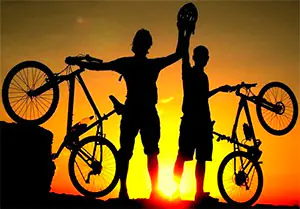In one of our previous articles, we already told you about such cool options for sports and healthy pastime, such as cycling, bike trip, and, of course, bike tour. For those who missed this very interesting and detailed review, we remind you that you can read it at this link. Therefore, we will not tell you again what it is in this article. Today we will focus on the question: what do you need to be able to do, and how to prepare yourself for this kind of collective sports event?
So, if bicycle rides in their essence can be both long and short, then a bicycle trip and a bicycle excursion involve an impressive long time behind the wheel of a bicycle. And also such an important point as safe collective riding in a group, convoy, on roads and routes with vehicular traffic and other serious aspects... Therefore, when deciding to participate in such events, your level of preparation should be significantly above average. You must be a beginner in cycling, and also confidently possess the basic key skills of riding your two-wheeled friend...
Preparing for a long bike ride, bike trip and bike tour.
In the initial period of training, it is recommended to cover a distance of 15-20 km; later, after 6-8 training sessions, you can gradually increase the training distance and bring it to 50-80 km.
The technique of skillful cycling involves mastering the following key elements:
- landing,
- pedaling,
- driving in a straight line,
- on turns,
- on ups and downs,
- braking,
- overcoming obstacles.
Landing. An experienced cyclist should sit in the saddle freely, without tension, as comfortably as possible. His hands are on the steering wheel, in a slightly bent position at the elbow joints, with the elbows slightly turned to the sides. The height of the saddle must be such that the lowered leg, with the heel on the pedal, is slightly bent. The torso leans forward, the head is raised, the gaze should be directed straight ahead.
Driving in a straight line comes down to proper pedaling technique with even foot pressure on the pedals. In a headwind, the body is lowered as low as possible to the steering wheel; in a tailwind, a high landing is assumed.
Riding on inclines. Short climbs must be overcome on the move after good acceleration. At the beginning of a long climb, the speed gained in a straight line is maintained; when it decreases, the pressure of the feet on the pedals increases to maintain sufficient pedaling speed.
Riding on descents. Accordingly, on descents, pedaling stops, the pedals are placed in a horizontal position, the cyclist leans low towards the handlebars and relaxes as much as possible. On long, gentle descents, reducing speed requires a series of rapid pedal revolutions.
Driving on turns. When approaching a turn, the speed decreases, the cyclist tilts the car and rolls towards the turn. In this case, the pedal on the turning side is set to the upper position, and the knee of the leg is moved to the side. On a sharp turn, especially on loose and slippery soil, a turning method with additional foot support on the ground is used. When cornering at high speed, you must not brake; this can lead to skidding and a fall. It is better to brake before turning, before the cyclist assumes the above-mentioned inclined position.
Braking on a road bike with a brake hub should be performed on older types of bicycles: by smoothly pressing the pedal in the opposite direction with the cranks in a horizontal position. On new ones: using a manual braking system on both front and rear wheels.
Overcoming obstacles. Wide ditches with gentle edges can be overcome at a walking pace with a bicycle in hand. Low obstacles are overcome at right angles to prevent the wheels from slipping. Individual stones, tree roots, narrow ditches are overcome by “jumping” or alternately lifting the front and, accordingly, rear wheels. Short sandy sections can be overcome while walking, long sandy sections can be overcome at a walk with a bicycle in hand. When driving on slippery ground (damp grass, clay, etc.), you should reduce your speed and avoid sudden changes and braking.
- Warm up. General part without a bicycle: slow running for men 10-12 minutes, for women - 8-10 minutes. General developmental exercises mainly for all parts of the body. Repeated squats on two, as well as on one leg. All kinds of standing and long jumps. Repeated running of 30-40 m segments. Special part on a bicycle: slow riding for 10-15 minutes.
- Main part. Improving riding technique (and all of the above elements) on a bicycle. Refining the landing, studying the correct pedaling, improving the technique of riding in a straight line, on ascents, descents, turns, braking and overcoming obstacles. Quality training using a) uniform, b) variable and c) repeated methods.
- Final part. Slow (calming) cycling for 5-7 minutes. Without a bicycle, slow smooth running and walking for 3-5 minutes, all kinds of cool-down exercises: relaxation with mandatory deep breathing.
Having mastered all these key elements, and having clocked up a decent number of kilometers on your meter, you can confidently sign up for groups on bike excursions, prepare your backpack for the upcoming bike trip, and now bike rides are just like sunflower seeds for you!
Post Views: 135


